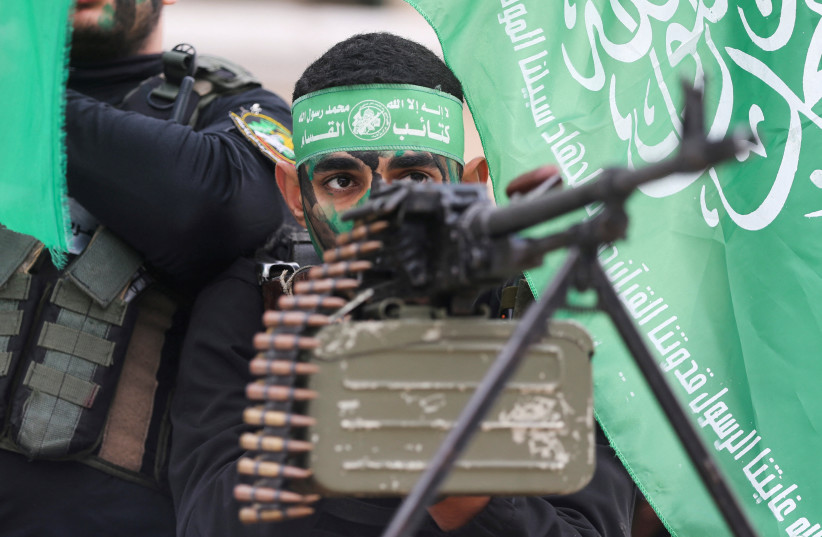Khan Yunis rocket fire is a wake-up call
On Monday, July 1 terrorists in Khan Yunis in Gaza fired twenty rockets at Israel. The attack should serve as a wake-up call that the terrorists in Gaza continue to pose a threat. These include Hamas and Palestinian Islamic Jihad and other groups that possess rockets and mortars. It also shows how these groups are able to quickly return to areas the IDF has vacated in Gaza, and set up new terrorist infrastructure.
The IDF said on Monday that “following the sirens that sounded a short while ago in communities near the Gaza Strip, approximately 20 projectiles were identified crossing from the area of Khan Yunis. A number of the projectiles were intercepted and some of the projectiles fell inside southern Israel. No injuries were reported. IDF Artillery is currently striking the sources of the fire.” The IDF put out a statement in Arabic on July 2 asking civilians to leave areas of Khan Younis. These types of calls usually happen prior to an IDF raid or strikes in an area.
Air strikes and another raid into Khan Younis is unlikely to get rid of the terrorists. Hamas has been shifting forces around Gaza. This is like one of those “cup games” where someone has three cups and shifts a small object from one cup to the next with the promise that if you choose the right cup you will get a reward. Today, Israel is like the sucker being asked to find the object under the cup, while Hamas moves its terrorists from cup to cup in Gaza.

Hamas and other terror groups have been emboldened in this tactic by the fact that Israel does not want to re-occupy all of Gaza at the same time. Instead the tactic in Gaza has been to go into areas and then leave. This is called “clear” and then leave not “clear and hold.”
For instance, the IDF went into northern Gaza in October and November after the Hamas attack on Israel. Then Israel went into Khan Younis in December. The IDF remained in Khan Younis until April, using the 98th Division to develop new tactics to remove Hamas terrorist infrastructure above and below ground. As the war shifted to a less intense conflict, the IDF then began to control the Netzarim corridor across Gaza. After March’s Ramadan, which was almost a de facto ceasefire, the IDF continued its raiding strategy. The raids located the bodies of seven hostages in Jabalya in May. The IDF also took over the Philadelphia corridor in May and entered Rafah, where operations continue. Now the IDF is also operating again in Shejaia in northern Gaza.
The overall trend of the war in Gaza is now to an even less “intense” war. This means a de facto ceasefire in most of Gaza. For instance electric lines to a desalination plant run by UNICEF was repaired recently. The IDF said “a new power line from Israel has been directly connected to a water desalination plant managed by UNICEF in Khan Yunis. This desalination plant supplies drinking water to the areas of Deir el-Balah, Khan Yunis, and al-Mawasi, where a large percentage of Gazans are currently located.” It’s worth noting the plant is in Khan Yunis. The rockets were fired from Khan Yunis.
This means basically that Hamas is once again thriving in many places in Gaza. As civilian infrastructure begins to be repaired Hamas will return even more. This is what Hamas did in the past. Each good deed, such as helping the desalination plant, will likely also come with Hamas bad deeds, as Hamas once again senses the war is winding down.
This is why the rocket fire should be a wake-up call. Hamas continues to control most of Gaza, with the exception of the corridor along the Egyptian border and the Netzarim corridor. It controls the cities. It has forces it has moved from places like Rafah, and this consists of thousands of fighters. A new Ynet report this week says Hamas is recruiting again in Gaza and that more evidence of recruitment is being found.
This means that Hamas will soon replace many of the thousands of fighters it lost in eight months of war. Hamas and other groups won’t be able to easily repair their rocket launching capabilities, however, their ability to control Gaza remains. While Israel has said its policy is to defeat Hamas capabilities, including governing capabilities, it is not clear how Israel can get to a new phase in Gaza so long as Hamas continues to easily control most areas in Gaza. It is not as if Hamas is being challenged. Repeated calls to evacuate areas, such as Zaytun or Khan Yunis now, have not produced a popular uprising against Hamas. The Arab states and others who might be interested in supporting an alternative in Gaza may be on board but they have not come up with a clear plan. Therefore the rocket fire continues to be a wake-up call.





Comments are closed.